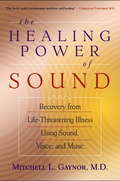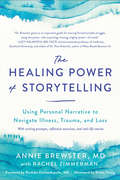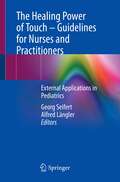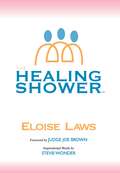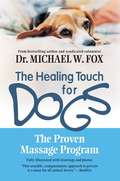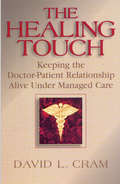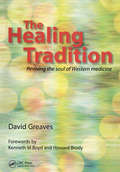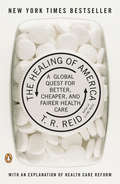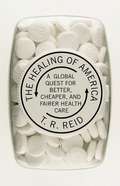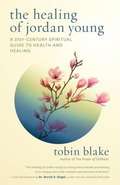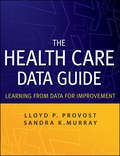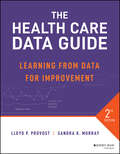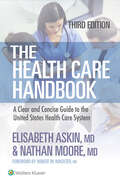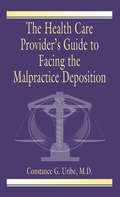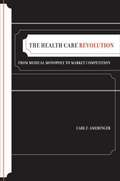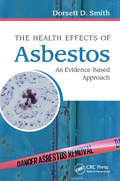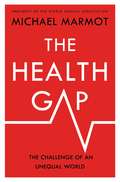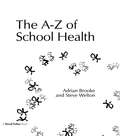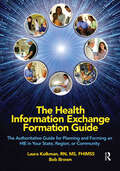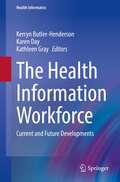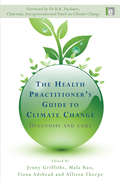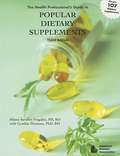- Table View
- List View
The Healing Power of Sound: Recovery from Life-Threatening Illness Using Sound, Voice, and Music
by Mitchell L. GaynorSince 1991, Dr. Mitchell Gaynor has been achieving remarkable results by integrating music, vocalization, breathing, and meditation techniques in his work with patients. In The Healing Power of Sound, he presents his sound-based techniques for self-healing--techniques that anyone can use, whether faced with a life-threatening disease or simply seeking relief from the stresses of daily life. Numerous studies have demonstrated the health benefits of music: it can lower blood pressure and heart and respiratory rates; reduce cardiac complications; increase the immune response; and boost our natural opiates. Gaynor shows how, when integrated as part of a mind-body-spirit approach to wellness, music can play a significant part in maintaining a healthy lifestyle or in healing serious disease. The Healing Power of Sound includes twelve exercises involving breathing, meditation, and "toning"--using pure vocal sound to resolve tension, release emotion, and spur the healing process--that can be used by anyone to improve health and quality of life.
The Healing Power of Storytelling: Using Personal Narrative to Navigate Illness, Trauma, and Loss
by Annie BrewsterReframe your story--and reclaim your life--through the transformative practice of writing and storytelling.When Harvard-trained physician Dr. Annie Brewster was diagnosed with multiple sclerosis in 2001, she realized firsthand that the medical system to which she&’d devoted her entire career was failing patients. The experience was dehumanizing. Her doctors weren&’t listening. And the confusion, fear, and shame she felt around her diagnosis was preventing her from truly healing, claiming her story, and living her fullest, richest life.The fact is, doctors can give you a life-changing diagnosis, but they&’re not equipped to help you deal with the inner fallout: the confusion, anxiety, trauma, and dread that comes after &“I have some bad news.&” Here, Dr. Brewster shows how writing your own unique healing story can help you process what comes next--to come to terms, create new ways to thrive, and even reclaim your personal power amid fear, change, and uncertainty. Dr. Brewster and journalist Rachel Zimmerman each share their own personal stories, acting as expert guides as you move forward on your healing journey. With exercises, reflections, writing prompts, and stories from other real patients, Dr. Brewster and Zimmerman show how you can: • Process the difficult emotions that come with life-changing diagnosis • Move beyond being the hero of your own story to become the author of your own story • Craft your narrative and share it in whatever medium speaks to you: music, audio, art, or writing • Integrate a traumatic health event into a new and evolving identity • Use applied storytelling techniques to strengthen connections between you and your loved ones (and even your care providers) • Cultivate resilience to move forward amid uncertainty and fear
The Healing Power of Touch – Guidelines for Nurses and Practitioners: External Applications in Pediatrics
by Georg Seifert Alfred LänglerThis book offers precise and highly informative instructions for nurses and caregivers on how to select external applications for various indications and how to perform them on children. It also enables readers to gain a deeper understanding of the skin, its functions and the therapeutic potential of external applications. The sense of touch is the first sensation that develops in the body during embryonal development; therefore, it is essential for orientation in the world from the beginning of life. The skin is known as the body's protective mantle. It is the largest sensory organ of the human body and plays a key role in perception, social interaction and health. Touch and external applications to the skin can have a lasting effect on overall health and wellbeing and contribute to the healing of various conditions in children. Through the skin, children react sensitively to external influences like natural active ingredients and touch. These mechanisms are particularly relevant with regard to the deep relationship between the skin and the organism as a whole. External applications use these mechanisms to support the health and healing processes in children. The book is intended for healthcare professionals interested in complementing conventional pediatric care with external applications, especially in daily use by nurses and caregivers. Nurses will find guidance from complementary medicine and care to deal with various indications occurring in various pediatric fields like pediatric surgery, psychiatry, oncology, intensive care, neonatology and during the phases of child development. In addition to the detailed descriptions of the application techniques, it provides insights into the theory behind external applications and explains the mechanisms of action. Furthermore, it includes case studies, scientific data and personal reports from experts.
The Healing Shower
by Judge Joe Brown Lake Payne Ywanda Scott Penny Juan Roberts John Sibley Eloise Laws Stevie WonderIt's time for loved ones to come together and celebrate positive energy before an ill family member goes off to receive intensive surgery, i.e. cancer. It's an occasion for wishing a person well ona safe and healthy road to recovery.
The Healing Touch for Dogs: The Proven Massage Program
by Michael W. FoxFrom the Book Jacket: "Massage has so many physical and psychological benefits for your dog that you could almost call it an essential of health care, like grooming, feeding, and exercise." -Dr. Michael W. Fox Distinguished veterinarian and animal psychologist Dr. Michael W. Fox shares his pioneering 6-step dog massage technique, which is not only a healing tool and health care measure, but also affirms the bond between you and your animal companion. Drawn from more than 30 years of experience, Dr. Fox provides an orientation to basic dog anatomy, physiology, and psychology, and then addresses, through easy to-read instructions and detailed illustrations and photos: Why dogs need massage; How to understand your dog's body language; How to develop a massage routine; How to diagnose illness with massage; and How to keep your dog fit and healthy. This newly revised and updated volume is an essential guide for helping and healing our animal companions. "The world-renowned veterinarian Michael W. Fox shares his years of wisdom and insights regarding the world of hands on healing and holistic medicine for our Kindred Spirits. Read it and help heal your animal friends!" -Allen Schoen, MS, DVM, author of Kindred Spirits: How the Remarkable Bond Between Humans and Animals Can Change the Way We Live Dr. Michael W. Fox, well known veterinarian and former vice president of the Humane Society of the United States, reaches millions of readers through the nationally syndicated newspaper column "Animal Doctor" with United Features, and is the author of more than 40 books on animal related issues, including The Healing Touch for Cats, The New Animal Doctor's Answer Book, and Love Is a Happy Cat.
The Healing Touch: Keeping the Doctor-Patient Relationship Alive Under Managed Care
by David L. CramThe traditional doctor-patient relationship is in jeopardy. In an era of "hurry up" medicine and "patient quotas," health care professionals are no longer able to apply good bedside manner—the healing touch. As the focus shifts from patients to profits, this vital component of patient care diminishes and may eventually be lost. In The Healing Touch, David Cram, M.D., a master clinician, teaches the art of good bedside manner and offers a valuable resource for health care professionals striving to preserve the doctor-patient relationship.
The Healing Tradition: Reviving the Soul of Western Medicine
by David GreavesThe Healing Tradition argues that Western medicine is fundamentally flawed because it fails to provide a healing environment for both individuals and society, and indicates potential ways to correct this through an integration model of medical humanities. All health professionals and those with an interest in medical humanities will find this book valuable reading.
The Healing of America
by Reid T. R.Bestselling author T. R. Reid guides a whirlwind tour of successful health care systems worldwide, revealing possible paths toward U. S. reform. In The Healing of America, New York Times bestselling author T. R. Reid shows how all the other industrialized democracies have achieved something the United States can’t seem to do: provide health care for everybody at a reasonable cost. In his global quest to find a possible prescription, Reid visits wealthy, free market, industrialized democracies like our own—including France, Germany, Japan, the U. K. , and Canada—where he finds inspiration in example. Reid shares evidence from doctors, government officials, health care experts, and patients the world over, finding that foreign health care systems give everybody quality care at an affordable cost. And that dreaded monster “socialized medicine” turns out to be a myth. Many developed countries provide universal coverage with private doctors, private hospitals, and private insurance. In addition to long-established systems, Reid also studies countries that have carried out major health care reform. The first question facing these countries—and the United States, for that matter—is an ethical issue: Is health care a human right? Most countries have already answered with a resolute yes, leaving the United States in the murky moral backwater with nations we typically think of as far less just than our own. The Healing of America lays bare the moral question at the heart of our troubled system, dissecting the misleading rhetoric surrounding the health care debate. Reid sees problems elsewhere, too: He finds poorly paid doctors in Japan, endless lines in Canada, mistreated patients in Britain, spartan facilities in France. Still, all the other rich countries operate at a lower cost, produce better health statistics, and cover everybody. In the end, The Healing of America is a good news book: It finds models around the world that Americans can borrow to guarantee health care for everybody who needs it. .
The Healing of America: A Global Quest for Better, Cheaper, and Fairer Health Care
by T. R. ReidT. R. Reid shows how all the other industrialized democracies have achieved something the United States can't seem to do: provide health care for everybody at a reasonable cost.
The Healing of America: A Global Quest for Better, Cheaper, and Fairer Health Care
by T. R. ReidA New York Times Bestseller, with an updated explanation of the 2010 Health Reform Bill Bringing to bear his talent for explaining complex issues in a clear, engaging way, New York Times bestselling author T. R. Reid visits industrialized democracies around the world--France, Britain, Germany, Japan, and beyond--to provide a revelatory tour of successful, affordable universal health care systems. Now updated with new statistics and a plain-English explanation of the 2010 health care reform bill, The Healing of America is required reading for all those hoping to understand the state of health care in our country, and around the world.T. R. Reid's newest book, A Fine Mess, will be published by Penguin Press in Spring 2017.
The Healing of Jordan Young
by Tobin BlakeWith love, all things can be healed Jordan Young had been dating author Tobin Blake’s daughter for two years when, days after his eighteenth birthday, he was diagnosed with an aggressive form of lymphoma. Within months, several rounds of chemotherapy had failed and top physicians determined that Young -- now on a ventilator in the ICU -- could not survive the widespread disease. But he did survive and, two years later, is cancer-free. This suspenseful narrative explores the anatomy of a miracle -- the precise steps Blake took with Young on his journey back from the brink. Young’s path shows how methods based on spiritual laws can be used to transform fear, navigate the medical world, guide family and friends, and, most important, heal. It illustrates that with love, all things can be healed, hope is always justified, and nothing is impossible -- no matter what the doctors tell you.
The Health Care Data Guide
by Sandra Murray Lloyd P ProvostThe Health Care Data Guide is designed to help students and professionals build a skill set specific to using data for improvement of health care processes and systems. Even experienced data users will find valuable resources among the tools and cases that enrich The Health Care Data Guide. Practical and step-by-step, this book spotlights statistical process control (SPC) and develops a philosophy, a strategy, and a set of methods for ongoing improvement to yield better outcomes.Provost and Murray reveal how to put SPC into practice for a wide range of applications including evaluating current process performance, searching for ideas for and determining evidence of improvement, and tracking and documenting sustainability of improvement. A comprehensive overview of graphical methods in SPC includes Shewhart charts, run charts, frequency plots, Pareto analysis, and scatter diagrams. Other topics include stratification and rational sub-grouping of data and methods to help predict performance of processes.Illustrative examples and case studies encourage users to evaluate their knowledge and skills interactively and provide opportunity to develop additional skills and confidence in displaying and interpreting data.Companion Web site: www.josseybass.com/go/provost
The Health Care Data Guide: Learning from Data for Improvement
by Lloyd P. Provost Sandra K. MurrayAn Essential text on transforming raw data into concrete health care improvements Now in its second edition, The Health Care Data Guide: Learning from Data for Improvement delivers a practical blueprint for using available data to improve healthcare outcomes. In the book, a team of distinguished authors explores how health care practitioners, researchers, and other professionals can confidently plan and implement health care enhancements and changes, all while ensuring those changes actually constitute an improvement. This book is the perfect companion resource to The Improvement Guide: A Practical Approach to Enhancing Organizational Peformance, Second Edition, and offers fulsome discussions of how to use data to test, adapt, implement, and scale positive organizational change. The Health Care Data Guide: Learning from Data for Improvement, Second Edition provides: Easy to use strategies for learning more readily from existing health care data Clear guidance on the most useful graph for different types of data used in health care A step-by-step method for making use of highly aggregated data for improvement Examples of using patient-level data in care Multiple methods for making use of patient and other feedback data A vastly better way to view data for executive leadership Solutions for working with rare events data, seasonality and other pesky issues Use of improvement methods with epidemic data Improvement case studies using data for learning A must read resource for those committed to improving health care including allied health professionals in all aspects of health care, physicians, managers, health care leaders, and researchers.
The Health Care Handbook: A Clear and Concise Guide to the United States Health Care System
by Elisabeth T. Askin Nathan MooreDescribed in the New York Times as “an astonishingly clear ‘user’s manual’ that explains our health care system and the policies that will change it,” The Health Care Handbook, by Drs. Elisabeth Askin and Nathan Moore, offers a practical, neutral, and readable overview of the U.S. health care system in a compact, convenient format. The fully revised third edition provides concise coverage on health care delivery, insurance and economics, policy, and reform—all critical components of the system in which health care professionals work. Written in a conversational and accessible tone, this popular, highly regarded handbook serves as a “one stop shop” for essential facts, systems, concepts, and analysis of the U.S. health care system, providing the tools you need to confidently evaluate current health care policy and controversies.
The Health Care Provider's Guide to Facing the Malpractice Deposition
by Constance G. Uribe M.D.An anesthesiologist chips a patient's tooth during a difficult intubation. A surgeon leaves tiny abrasions on a patient's abdomen during a delicate surgical procedure. And an operating room nurse accidentally nips a patient's finger with a pair of scissors.Not all of these examples of medical mistakes will result in malpractice suits. But for the o
The Health Care Revolution: From Medical Monopoly to Market Competition
by Carl F. AmeringerThis book explains how the revolution of America's market-based health care system came into being when the U.S. Supreme Court and Congress prompted the antitrust agencies of the federal government to change the rules of the health care system. Ameringer lays out the key events that led up to this regime change; explores its broader social, political, and economic contexts; examines the views of both its proponents and opponents; and considers its current trajectory.
The Health Debate 2nd edition (Policy and Politics in the Twenty-First Century)
by David J. HunterHealth care systems everywhere face multiple pressures from changing demography, the rise of non-communicable disease, the growing demand on health services, and limited resources at a time of austerity. Focusing on the British NHS from a political science perspective, this second edition of this best-selling book offers a fresh look at how it is coping with such pressures. The book explores the complexity of health policy and health services, offering a critical perspective on concerns including integrated care, the return of public health to local government and moves to devolve health services to local level. Crucially, it offers a critique of the market-style changes introduced by the Coalition government between 2010 and 2015. Students of health care and health policy, policy-makers and public health and health care professionals will find this lively and accessible reassessment of NHS reforms invaluable.
The Health Effects of Asbestos: An Evidence-based Approach
by Dorsett D. SmithThe health-related effects of asbestos have long been mired in controversy, with industry and plaintiff attorneys playing a significant role. This comprehensive book provides a balanced and extensive evidence-based critical analysis of the literature concerning asbestos-related diseases, from a scientific and historical perspective. The book presen
The Health Gap: The Challenge of an Unequal World
by Michael Marmot<p>In this groundbreaking book, Michael Marmot, president of the World Medical Association, reveals social injustice to be the greatest threat to global health <p>In Baltimore’s inner-city neighborhood of Upton/Druid Heights, a man’s life expectancy is sixty-three; not far away, in the Greater Roland Park/Poplar neighborhood, life expectancy is eighty-three. The same twenty-year avoidable disparity exists in the Calton and Lenzie neighborhoods of Glasgow, and in other cities around the world. <p>In Sierra Leone, one in 21 fifteen-year-old women will die in her fertile years of a maternal-related cause; in Italy, the figure is one in 17,100; but in the United States, which spends more on healthcare than any other country in the world, it is one in 1,800. Why? <p>Dramatic differences in health are not a simple matter of rich and poor; poverty alone doesn’t drive ill health, but inequality does. Indeed, suicide, heart disease, lung disease, obesity, and diabetes, for example, are all linked to social disadvantage. In every country, people at relative social disadvantage suffer health disadvantage and shorter lives. Within countries, the higher the social status of individuals, the better their health. These health inequalities defy the usual explanations. Conventional approaches to improving health have emphasized access to technical solutions and changes in the behavior of individuals, but these methods only go so far. What really makes a difference is creating the conditions for people to have control over their lives, to have the power to live as they want. Empowerment is the key to reducing health inequality and thereby improving the health of everyone. Marmot emphasizes that the rate of illness of a society as a whole determines how well it functions; the greater the health inequity, the greater the dysfunction. <p>Marmot underscores that we have the tools and resources materially to improve levels of health for individuals and societies around the world, and that to not do so would be a form of injustice. Citing powerful examples and startling statistics (“young men in the U.S. have less chance of surviving to sixty than young men in forty-nine other countries”), The Health Gap presents compelling evidence for a radical change in the way we think about health and indeed society, and inspires us to address the societal imbalances in power, money, and resources that work against health equity.</p>
The Health Handbook for Schools
by Adrian Brooke Steve WeltonThis handbook allows rapid reference to conditions commonly encountered in school-aged children, and to rare diseases as well. It focuses particularly on the impact of the condition on the child's ability to access the curriculum, and suggests educational approaches that should help. In this way it is hoped that education and medicine can work hand in hand to allow each child to achieve their potential. The book offers: essential information on medical conditions and the way they affect learning; up-to-date descriptions of symptoms, signs and current key concepts; current educational approaches taken to accommodate children with the conditions and problems listed; and advice on diagnosing and responding to acute illness such as meningitis (what to do with a child who might have it, what happens to the rest of the school if it is diagnosed in one child).
The Health Impact of Smoking and Obesity and What to Do About It
by David Mclean Hans Krueger Dan Williams Barbara KaminskyDespite significant progress due to public health campaigns and other policy efforts, smoking continues to be a serious health threat throughout the world. In addition, sedentary lifestyles, poor diet, and obesity continue to be major causes of chronic diseases. The Health Impact of Smoking and Obesity and What to Do about It synthesizes a vast quantity of recent data on the benefits and cost-effectiveness of both clinical and public health interventions in addressing the risk factors of smoking and obesity.A large proportion of chronic disease is preventable. The Health Impact of Smoking and Obesity and What to Do about It provides solid evidence and practical advice to health care planners, decision-makers, and frontline providers alike. The volume discusses various approaches to measuring disease burden and setting health care targets, and provides a summary of interventions of proven effectiveness. Taking into account the vital lessons learned from the experience of tobacco control over forty years, and focusing on the current state of the evidence for obesity control, the study stresses the importance of comprehensive strategies that deal with both individual behaviour changes and the need to encourage social contexts that enhance healthy choices and lifestyles.
The Health Information Exchange Formation Guide: The Authoritative Guide for Planning and Forming an HIE in Your State, Region or Community (HIMSS Book Series)
by Bob Brown Laura KolkmanWinner of HIMSS 2011 Book of the Year Award!The HIMSS Book of the Year Award honors a book that offers outstanding practical guidance and/or strategic insight for healthcare information and management systems professionals. "The electronic exchange of health information is an essential capability that contributes to improved efficiency and patient outcomes in the healthcare delivery process. This book provides readers with the tools and resources needed to establish a successful, sustainable HIE and avoid many of the pitfalls that failed early initiatives. The authors use their own direct experience as HIE consultants, their interviews with HIE leaders and extensive research to offer a practical, step-by-step approach to forming an HIE. The book features case studies, examples, checklists, references, a high-level history and overview of HIE and a discussion of why HIE is so important. The book also describes in detail the essential steps to planning and forming a successful HIE. By providing the necessary tools and framework, the book serves to advance the successful development of HIEs and improve efficiency and outcomes in the healthcare delivery process. During a time of unprecedented change in the healthcare landscape, this guide is a timely and valuable resource for those seeking to leverage HIE to achieve quality gains and billions of dollars in saving under healthcare reform."
The Health Information Workforce: Current and Future Developments (Health Informatics)
by Karen Day Kathleen Gray Kerryn Butler-HendersonThis book provides a detailed guide to the highly specialised but little known health information workforce - people who are health informaticians, digital health experts, and managers of health data, health information and health knowledge. It explains the basis of their unique functions within healthcare – their educational pathways and standards, professional qualifications and industry certifications, scholarly foundations and principles of good practice. It explores their challenges, including the rise of the health consumer movement, the drive to improve equity and quality in healthcare, new technologies such as artificial intelligence, and the COVID-19 infodemic. Case studies describe how practitioners in real-world roles around the world are addressing the digital transformation of health. The Health Information Workforce: Current and Future Developments offers insights into a skilled group of people who are essential for healthcare services to function, for care providers to practice at the top of their scope, for researchers to generate significant insights, and for care consumers to be empowered participants in health systems. This book offers new perspectives for anyone working or intending to work in the health sector. It is a critical resource for health workforce planners, employers and educators seeking guidance on the specialised capabilities needed for high performance in an increasingly information-intensive sector.
The Health Practitioner's Guide to Climate Change: Diagnosis and Cure
by Jenny Griffiths Fiona Adshead Mala Rao Allison ThorpeHighly commended in the Public Health category, BMA Medical Awards 2010 There are enormous health benefits from tackling climate change. This is the first book to set out what health practitioners can do to prevent the worst impacts of climate change, to make health services sustainable, and to design healthy, sustainable communities. The book: - provides an introduction for health practitioners and students to climate change and its current and future health impacts - describes the relationship between health and the environment - gives facts and figures on greenhouse gas emissions - sets out the huge benefits to health of acting on climate change - explains what health practitioners can do - at home, at work and in their organizations, and - shows how you can support action in communities, nationally and globally. Essential reading for: - health professionals, local government, built environment professionals - students across all sectors of health, medicine and public administration - community and voluntary sector, NGOs - the business community involved in private healthcare. The Health Practitioner's Guide to Climate Change is written by an authoritative group of authors from key organisations in the field, including the Met Office, the Faculty of Public Health, Natural England, the London School of Hygiene and Tropical Medicine, the Climate and Health Council, the NHS Sustainable Development Unit, the Health Protection Agency, the University of the West of England, Sustrans and the National Social Marketing Centre. Sponsored by The National Heart Forum and the National Social Marketing Centre. Foreword by Dr. R.K. Pachauri, Director General, The Energy and Resources Institute (TERI) and Chairman, Intergovernmental Panel on Climate Change (IPCC)
The Health Professional's Guide to Popular Dietary Supplements (Third Edition)
by Allison Sarubin-Fragakis Cynthia ThomsonTwenty-nine new dietary supplements have been added to this edition! This guide comprehensively explores the media claims, drug-supplement interactions, dosage information and relevant research for more than 100 of today's most popular dietary supplements. Completely revised, updated, and indexed information is provided for dietetics professionals and their clients. Written by industry experts, this guide's recommendations are reliable and backed by credible clinical research.
